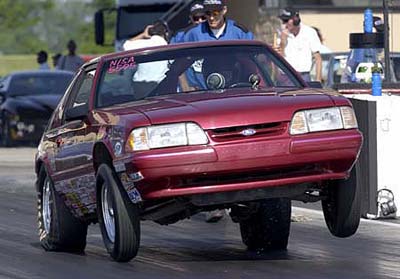|
Project Muscrate
By Jay Roeder
2/9/04
Hello everyone,
and welcome to Project "Muscrate"! Ed. note:
(You know, Mustang + crate motor= Muscrate ...
ha ha.) First in a series of articles to come,
I will be able to shed a little light on the
inner workings of an IHRA / NHRA Stock Eliminator
class car. Also, I will highlight some of the
"little things" that separate a class car from
an E.T. car in terms of why, how and how much
does it cost to field a competitive stocker.
Many of the techniques and theories that apply
to a class car are fairly easy and worthwhile
to apply to the "weekend warrior" that does
battle at the local tracks around the country.
 My
first "race car" if you will, was a 1980 Mercury
Capri with the worst excuse of a V-8 ever built,
a 255 cu. in. 2 barrel. I ran the car in Trophy
class the first part of the season, knocking
down some blistering low 17 second E.T.'s and
actually did pretty well. Midway through the
year I talked my dad into letting me install
a stock 351W with a 4 barrel into my steed.
High 14-second time slips became the norm and
I was pretty happy to finally have the horsepower
to do a burnout! (Not that I needed a burnout
of course, but that was cool!) I did well enough
with the car that I really didn't want any more
trophies, so the track owner at the time, DRO's
very own Jok Nicholson, started giving me free
entry to the following weekends' race. My
first "race car" if you will, was a 1980 Mercury
Capri with the worst excuse of a V-8 ever built,
a 255 cu. in. 2 barrel. I ran the car in Trophy
class the first part of the season, knocking
down some blistering low 17 second E.T.'s and
actually did pretty well. Midway through the
year I talked my dad into letting me install
a stock 351W with a 4 barrel into my steed.
High 14-second time slips became the norm and
I was pretty happy to finally have the horsepower
to do a burnout! (Not that I needed a burnout
of course, but that was cool!) I did well enough
with the car that I really didn't want any more
trophies, so the track owner at the time, DRO's
very own Jok Nicholson, started giving me free
entry to the following weekends' race.
My racing program evolved over the next few years and included a 1978 Mustang II with a 351C. I raced in the No Box class at CFR for a couple of years, and it ran middle 12's @ 105 mph. It was a pretty basic car and it did fairly well for me, winning a few races along the way.
Next up was the car that was the beginning of my desire to figure out how to
make cars go fast. It was another Mustang II
that I bought from a friend that had lost interest.
It had a homemade tube chassis, 14x32's and
a hood scoop. A real race car was in my
ADVERTISEMENT
 |
possession!
It was rather portly for a "chassis car," all
steel except the hood, 460 BBF, C-6 Trans.,
9 in. out back, and wheelie bars (not that it
needed them)). It weighed about 2900 lbs. The
problem was I could not get that damn car to
run 10's.
One day, my good friend and mentor, Jim Kramer,
was giving me crap because a friend of his was
running some high 10's with a 427 in mostly
stock trim. At the time I didn't know a stocker
from a hole in the ground, other than what Jim
had continuously been telling me. I thought,
"Yeah right, I'll just bet he goes that fast
with mostly stock stuff." Well, you know what,
he did. His name was Roger Knudsen. Roger lost
his battle with cancer a few years ago, but
he was without a doubt my inspiration to learn
how to make cars go fast. I could not fathom
how he could run the numbers that he did without
buying half the products that Jegs or Summit
pedaled in their wish books.

|